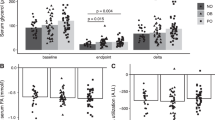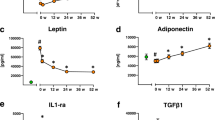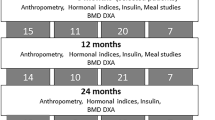Abstract
The intra-abdominal visceral deposition of adipose tissue, which characterises upper body obesity, is a major contributor to the development of hypertension, glucose intolerance and hyperlipidaemia. Conversely, individuals with lower body obesity may have comparable amounts of adipose tissue but remain relatively free from the metabolic consequences of obesity. This raises an obvious question—are there particular weight reducing treatments which specifically target intra-abdominal fat? In theory, surgical removal of upper body fat should be effective. In reality, neither liposuction nor apronectomy (‘tummy tuck’) have any beneficial metabolic effects, they simply remove subcutaneous adipose tissue which is often rapidly replaced. Vertical banded gastroplasty and gastric bypass operations may be dramatically effective in improving blood pressure, insulin sensitivity and glucose tolerance. However, these benefits result from a parallel reduction in visceral and total body fat. Studies of body fat distribution in postmenopausal women confirm that the marked decrease in adiposity, following a programme of very low calorie diet and exercise, reflects a comparable reduction in visceral and thigh fat. The reduction in waist circumference after a low fat/exercise programme suggests a similar situation in men. Exercise has an important role in treatment but, once again, the fat loss is generalised. Nevertheless, the improved metabolic parameters seen in exercising obese subjects, independent of weight loss, suggest other beneficial actions. Growth hormone (GH) has a marked lipolytic action. GH replacement treatment for GH deficient adults with pronounced abdominal fat deposition, has been shown to reduce intra-abdominal fat by 47% compared to 27% decrease in abdominal subcutaneous fat. Similar beneficial actions on abdominal fat have been reported following treatment with testosterone in obese men. The potential hazards of such treatments make them unsuitable therapy for obesity. Dexfenfluramine is effective in reducing total body fat but the results from a six month randomised controlled trial indicates that it does not specifically influence changes in waist circumference associated with weight loss. In conclusion, any treatment which reduces total body fat will, by its nature, reduce intra-abdominal visceral fat. There are presently no specific treatments which can be recommended for intra-abdominal fat but increasing knowledge of the biochemical aberrations associated with visceral adiposity may lead to more specific therapies for the future.
This is a preview of subscription content, access via your institution
Access options
Subscribe to this journal
Receive 12 print issues and online access
$259.00 per year
only $21.58 per issue
Buy this article
- Purchase on Springer Link
- Instant access to full article PDF
Prices may be subject to local taxes which are calculated during checkout
Similar content being viewed by others
Author information
Authors and Affiliations
Rights and permissions
About this article
Cite this article
Kopelman, P. The effects of weight loss treatments on upper and lower body fat. Int J Obes 21, 619–625 (1997). https://doi.org/10.1038/sj.ijo.0800458
Received:
Revised:
Accepted:
Issue Date:
DOI: https://doi.org/10.1038/sj.ijo.0800458
Keywords
This article is cited by
-
Single-blind, placebo controlled randomised clinical study of chitosan for body weight reduction
Nutrition Journal (2015)
-
Characteristics, changes and influence of body composition during a 4486 km transcontinental ultramarathon: results from the Transeurope Footrace mobile whole body MRI-project
BMC Medicine (2013)
-
Ageing and metabolism: drug discovery opportunities
Nature Reviews Drug Discovery (2005)
-
Visceral fat loss evaluated by total body magnetic resonance imaging in obese women operated with laparascopic adjustable silicone gastric banding
International Journal of Obesity (2000)



